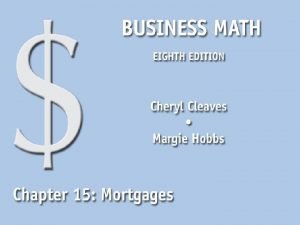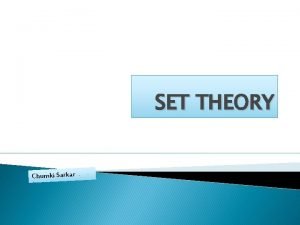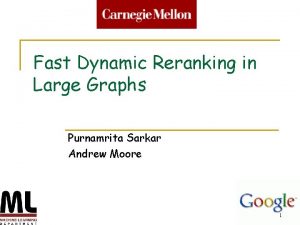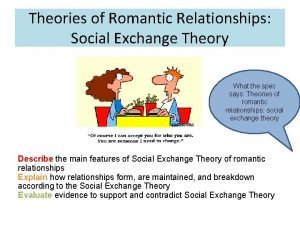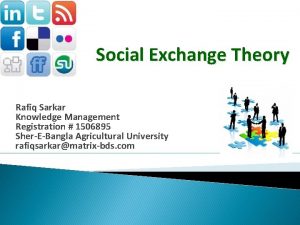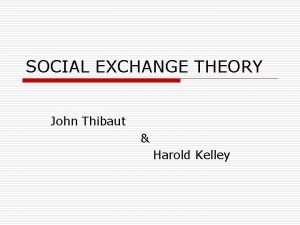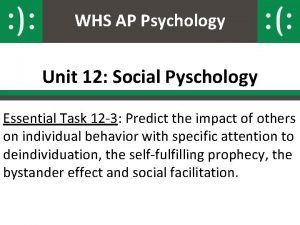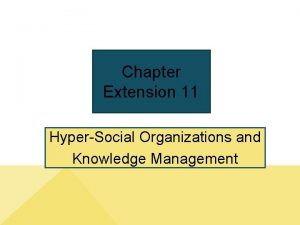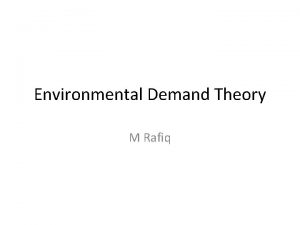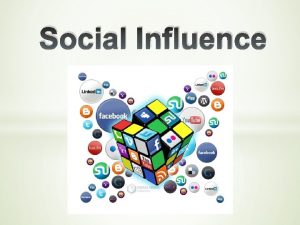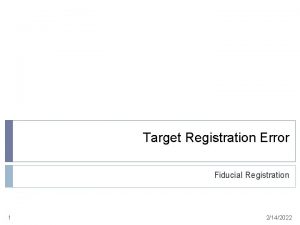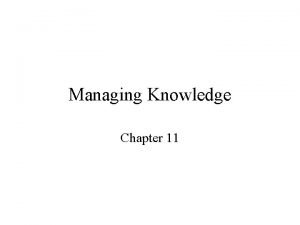Social Exchange Theory Rafiq Sarkar Knowledge Management Registration



























- Slides: 27

Social Exchange Theory Rafiq Sarkar Knowledge Management Registration # 1506895 Sher-E-Bangla Agricultural University rafiqsarkar@matrix-bds. com

Definition � Social exchange theory is a social-psychological and sociological perspective that explains social change and stability as a process of negotiated exchanges between parties • Social exchange theory posits that human relationships are formed by the use of a subjective cost-benefit analysis and the comparison of alternatives. The theory has roots in economics, psychology and sociology

General Assumptions � � � If people define situations as real, they will be real in their consequences. Social facts do not have any inherent meaning other than that which humans attribute to them. Social exchange theory suggests that we essentially take the benefits and minus the costs in order to determine how much a relationship is worth. Positive relationships are those in which the benefits outweigh the costs, while negative relationships occur when the costs are greater than the benefit social exchange as the exchange of activity, tangible or intangible, and more or less rewarding or costly, between at least two persons – George Homan – 1958 All behaviour is a series of exchanges. Individuals want to maximise rewards and minimise costs. If a relationship is to be successful then both parties are expected to give and take in equal proportions.

History Social exchange theory was introduced in 1958 by the sociologist George Homans with the publication of his work "Social Behavior as Exchange“ � After Homans founded theory, other theorists continued to write about it, particularly Peter M. Blau and Richard M. Emerson, who in addition to Homans are generally thought of as the major developers of the exchange perspective within sociology � Peter Blau - social exchange theory more towards the economic and utilitarian perspective, whereas Homans focused on reinforcement principles which presuppose individuals base their next social move on past experiences. � Blau felt that if individuals focused too much on the psychological concepts within theory, they would refrain from learning the developing aspects of social exchange �

Social exchange theory was introduced in 1958 by the sociologist George Homans with the publication of his work "Social Behavior as Exchange“

Self-interest and Interdependence � Self-interest and interdependence are central properties of social exchange � Homans uses the concepts of individualism to explain exchange processes. To him, the meaning of individual selfinterest is a combination of economic and psychological needs � Fulfilling self-interest is often common within the economic realm of the social exchange theory where competition and greed can be common � In social exchange, self-interest is not a negative thing; rather, when self-interest is recognized, it will act as the guiding force of interpersonal relationships for the advancement of both parties’ self-interest" — Michael Roloff (1981)

Basic concepts Exchange as a social behavior that may result in both economic and social outcomes � Generally analyzed by comparing human interactions with the marketplace � Every individual is trying to maximize his wins. Once this concept is understood, it is possible to observe social exchanges everywhere, not only in market relations, but also in other social relations like friendship. � The process brings satisfaction when people receive fair returns for their expenditures. The major difference between social and economic exchange is the nature of the exchange between parties. Neoclassic economic theory views the actor as dealing not with another actor but with a market and environmental parameters, such as market price � Social exchanges involve a connection with another person; involve trust and not legal obligations; are more flexible; and rarely involve explicit bargaining �

� � Cost and rewards ◦ social exchange models assume that rewards and costs drive relationship decisions Both parties in a social exchange take responsibility for one another and depend on each other. The elements of relational life include: ◦ Costs are the elements of relational life that have negative value to a person, such as the effort put into a relationship and the negatives of a partner- (Costs can be time, money, effort etc. ) ◦ Rewards are the elements of a relationship that have positive value. (Rewards can be sense of acceptance, support, and companionship etc. ) ◦ Worth = Rewards – Costs ◦ If worth is a positive number, it is a positive relationship, a negative number indicates a negative relationship

� Positive relationships are expected to endure, whereas negative relationships will probably terminate. Mutual relationship satisfaction ensures relationship stability � Outcome = Rewards – Costs

Human Behavior � The Five Propositions of All Human Behavior ◦ The Success Proposition: If an activity was previously rewarded, then the individual is more likely to repeat the activity again. ◦ The Stimulus Proposition: Principle of experience. If a similar stimulus presents itself and resembles an originally awarded activity, the individual is likely to repeat that course of action. ◦ The Value Proposition: Principle of value of outcome. The more valuable to an individual a unit of the activity another gives him/her, the more often he/she will emit the activity rewarded by the activity of the other. (watching football) ◦ The Deprivation-Satiation Proposition: Principle of diminishing returns. Someone who goes a long time without a desired reward becomes far more willing to engage in behavior that will lead to desired reward. (Being away from loved ones) ◦ The Aggression-Approval Proposition: When a behavior does not receive expected reward, the response is anger or aggression. (Students grades)

The Group System � Elements ◦ Activity: What the members of a group do as members. ◦ Interaction: Relation of the activity of one member of the group to that of another. ◦ Sentiment: The sum of the feelings of group members with respect to the group. ◦ Norms: Code of behavior adopted consciously or unconsciously by the group.

Power and Authority Homans felt that a person who influences other members has authority. � An individual earns authority by acquiring esteem and acquires esteem by rewarding others. � Power can be defined as the ability to provide valuable rewards. � When directing others, the leader inevitably causes the members to incur costs. The leader’s incurring costs will help prevent conflict. � Example: If employees are asked to work late, they will be less upset if the boss also stays and works late. �

Elements of Social Exchange Theory Thibaut & Kelley (1959) & Homans (1961) Perceived profit = rewards – costs (pp=r-c) � We are all in relationships for profit. � We leave relationships when we no longer perceive them as profitable or when the costs of staying outweigh the rewards. � Self-interest (WIIFM) � Seek fair outcomes, distributive justice, and equity � Alter own behavior or seek to alter others’ behavior to achieve desired outcomes � Exchange of resources via transactions �

Perceived Profit What individuals perceive they are profiting by being in the relationship (may or may not be “reality”) � Different and unique for each person � Can be extremely high or close to no profit � As long as both parties view the relationship as profitable, the relationship can endure. �

Rewards � What we give each other in relationships � What things do you get out of your relationships that you highly value? Types of Reward • Cash • Goods • Services • Sentiments

Reward Problematics � Reward Deprivation – occurs when there is a type of reward one “perceives” a great need for but are not getting (and literally crave that reward). An individual may even leave the relationship and/or cheat to get what they perceive they need. � Reward Satiation – occurs when one receives “too much of a good thing” and a particular reward comes to have little value, even if it was once important.

Costs � Inherent (actual) – time, money, energy � Psychological – stress of giving the reward � Rewards Foregone – what one gives up in order to give another a reward

Principles of Social Exchange Theory Principle of Reward � The more often a particular action of a person is rewarded, the more likely the person is to perform that action Principle of Experience � If an individual’s action has been rewarded in the past, then the individual will enact the same action in circumstances similar to the one in which the previous action was rewarded Principle of Value of Outcome � The more a person values the result of an action, the more likely s/he is to perform that action.

Principle of Diminishing Returns � The more often in the recent past a person has received a particular reward, the less valuable any further unit of that becomes. � Reward Satiation Principle of Distributive Justice � When an action does not produce an expected reward, or causes unexpected punishment, a person will feel cheated and is likely to engage in punitive actions. � When an action produces an unexpected reward, or when it does not produce expected punishment, a person ingratiated or obligated will likely engage in approving behavior

Principle of Rationality � ln any decision situation, a person will choose that action for which, as perceived by him/her at the time, the value of the result multiplied by the probability of getting the result, is the greatest. Principle of Least Interest � The person who has the least interest in continuing the relationship is able to control the relationship and exploit the other partner. � In studying college dating: Men financial & emotional investment for physical affection Women sexual investment to gain attention and commitment

Achieving Balance � Individuals will often endure what seems like extreme costs if they perceive future payoffs. � Individuals seek to create ultimate exchanges in which both people feel they are profiting highly but experiencing little, if any, costs. � Obligation can occur when exchanges are uneven and a sense of indebtedness is created. � When couples struggle, it is seldom simply over who does what. Far more often, it is over the giving and receiving of gratitude (Hochschild, 1989).

Homans's theoretical propositions � � v v v an individualistic approach, a major goal of his work was to explicate the micro-foundations of social structures and social exchange. social structures emerge from elementary forms of behavior The first proposition: the Success Proposition states that behavior that creates positive outcomes is likely to be repeated The second proposition: the Stimulus Proposition believes that if an individual's behavior is rewarded in the past, the individual will continue the previous behavior The third proposition: the Value proposition believes that if the result of a behavioral action is considered valuable to the individual, it is more likely for that behavior to occur The fourth proposition: the Deprivation-satiation proposition believes that if an individual has received the same reward several times, the value of that reward will diminish. The fifth proposition: discusses when emotions occur due to different reward situations. Those who receive more than they expect or do not receive anticipated punishment will be happy and will behave approvingly


Modes of exchange "It must be oriented towards ends that can only be achieved through interaction with other persons, and it must seek to adapt means to further the achievement of these ends“ � mutual reinforcement by two parties of each other's actions � The process begins when at least one participant makes a “move, ” and if the other reciprocates, new rounds of exchange initiate. Once the process is in motion, each consequence can create a selfreinforcing cycle. � Norms, beliefs, interest to exchange and receipt �

Critiques � The theory reduces human interaction to a purely rational process that arises from economic theory. � The theory favors - when ideas of freedom and openness were preferred, but there may be times when openness isn’t the best option in a relationship. � The theory assumes that the ultimate goal of a relationship is intimacy when this might not always be the case. � The theory places relationships in a linear structure, when some relationships might skip steps or go backwards in terms of intimacy

Examples of Implication

 Salam barkat rafiq jabbar
Salam barkat rafiq jabbar Rafiq's monthly mortgage payment
Rafiq's monthly mortgage payment Rafiq hasan
Rafiq hasan Taher haveliwala
Taher haveliwala High speed pcb material
High speed pcb material Chumki sarkar
Chumki sarkar Nnnmodel
Nnnmodel Dr anirban sarkar
Dr anirban sarkar Purnamrita sarkar
Purnamrita sarkar Purnamrita sarkar
Purnamrita sarkar Richard emerson social exchange theory
Richard emerson social exchange theory Examples of social exchange theory
Examples of social exchange theory Thibaut and kelley
Thibaut and kelley 10 theories used in public relations
10 theories used in public relations Ap psych unit 12
Ap psych unit 12 Just world hypothesis
Just world hypothesis Knowledge hub registration
Knowledge hub registration Real exchange rate vs nominal exchange rate
Real exchange rate vs nominal exchange rate Pearl exchange activity
Pearl exchange activity Gas exchange key events in gas exchange
Gas exchange key events in gas exchange Hyper social organization
Hyper social organization Knowledgexchange (cigna.com)
Knowledgexchange (cigna.com) Knowledge exchange cigna
Knowledge exchange cigna Social thinking and social influence
Social thinking and social influence Social thinking social influence social relations
Social thinking social influence social relations Shared and personal knowledge
Shared and personal knowledge Knowledge shared is knowledge squared
Knowledge shared is knowledge squared Knowledge shared is knowledge multiplied interpretation
Knowledge shared is knowledge multiplied interpretation

